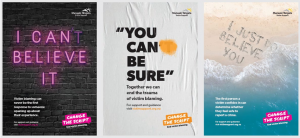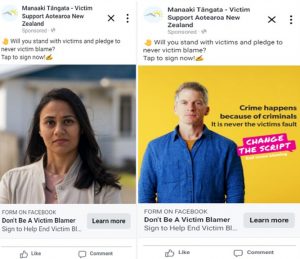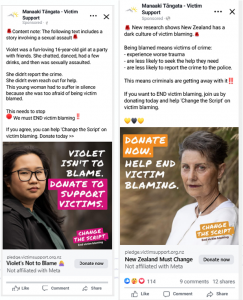
How to Make a Successful Behaviour-Changing Campaign
Last Thursday, during the latest Victims’ Rights Communicators Network, we had the privileged to have Manaaki Tāngata | Victim Support explaining how they planned, organized and led a successful nation-wide campaign to stop victim blaming. You can find the recorded webinar and the PowerPoint presentation below.
How can qualitative data be presented to induce changes in behaviour? And how do you create a nation-wide message that is able to resonate with the most amount of people possible? These are some of the questions Kalimar Edivy-James, the general manager of fundraising and communications, Tess Wicks, senior communications advisor, and Isabelle Cameron, the directing marketing specialist, of Manaaki Tāngata | Victim Support, faced.
After a months’ long research, they discovered that victim blaming, the act of shifting the blame from the perpetrator to the victim, was ingrained in Kiwi culture and that harmful stereotypes contribute to it. Furthermore, they learnt that the first person a victim tells what they’ve been through is a “make or break” moment as it is a decisive factor in their decision to report the crime. In summation, to end victim blaming and help victims finds support, there needed to be a society-wide mind-set shift.
They realized that this research was important and that they had to do something with it. Thankfully, an opportunity arose: they would be able to do a nationwide campaign thanks to leadership buy in, budget, and more. They were able to work with a creative firm that worked pro bono for them and came up with a concept: addressing the problems with common first responses to victims.

This creative was not only visually impactful but it also presented the problem in a clear and straightforward way. They decided to frame the campaign around two-person conversations rather than graphic stories, to avoid retrumatisation and to emphasise on positive behaviour – “tell them it’s not their fault” – with trauma-informed speech – empowering rather than shaming as well as simple yet strong and sticky
Due to the tight budget of this campaign, Manaaki Tāngata | Victim Support made sure to leverage their relationships to help with distribution. They created an online campaign pack for partners so they could share the campaign easily. Additionally, they used political and cold-called national billsticker companies to ask if they did any pro-bono work. Finally, they organized the distribution in three key phases:
- Awareness: Educate the general public on victim blaming using insights from their research to build trust and recognition. They used a blend of paid, earned and owned channels.
- Lead generation: Using Meta, they targeted people with interests in social change, charities, and other topics that overlapped with their campaign.
- Donation: Utilizing the leads and the “warm” audiences of the awareness campaign, they distributed donation posts and links.

During the first two phases of the campaign, their digital advertising focused into turning awareness into actions by encouraging people to “Take the pledge to End Victims Blaming” by signing a form. This gave them a way to live their values and actually stand with victims. The speakers explained that, as trust takes time, the pledge was designed as a low-barrier first step – a safe, positive, and empowering way to begin a relationship with Victim Support before introducing the fundraising.

As the campaign entered the third phase, their creatives evolved to how you can make a difference. This was done with new social media visuals, personalised emails to every pledge and a telemarketing follow-up to encourage donations.
The success of this campaign can be attributed to Manaaki Tāngata | Victim Support’s constantly trying different things like new creatives, messaging and audiences. These campaigning efforts prove the importance of research and statistics for people to hear your message. To be able to expand your message on social media and on public spaces, you need to approach partner organisations, networks, media and advertising companies, as It never hurts to ask and everything helps.
This event was a testament of the importance of victim support services and understanding your audience and the general public. In order to make a change, you need to understand the society that needs to change, what resonates with them and how you can successfully reach them.
We would like to profoundly thank Manaaki Tāngata | Victim Support’s for leading this workshop and teaching us about your incredible victim support efforts.
Watch the webinar here
Download the PowerPoint Presentation here
